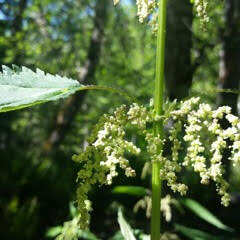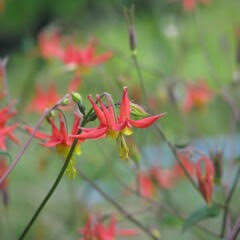Special Topics in Horticulture: Environmental Stewardship
Student Blog Post by Rachel Prat and Victoria Murdoch
Introduction
We had the pleasure of getting to speak to Kristen Miskelly over a zoom call about Environmental Stewardship. She is the owner of SatinFlower Nurseries, which specializes in native plant gardening. They sell wholesale and retail potted native plants to the community, as well as seeds: custom, blends, and packs. They also provide education through consultations, workshops, and courses. Our wonderful talk with Kristen taught us many things; such as how we can protect and restore ecosystems.
How do ecosystems become damaged in the first place?
Ecosystems become damaged for a number of reasons. The main ones being human population & development, the introduction of invasive species, and the use of herbicides & pesticides. Our population keeps growing and in turn ecosystems are being destroyed in order to build more homes and infrastructure. As well as the pollution humans create with cars and other machinery that damages plant life all the same. When it comes to introducing invasive species, it is usually not done intentionally but rather with the purpose of bringing over something new and different from another part of the world because it's pretty and people want it in their garden; unaware that the plant becomes invasive in their part of the world. Interestingly, native plants are never invasive. It is when they are taken from their native land and placed elsewhere that they have the potential to become invasive. Lastly, herbicide and pesticide use can have a major impact on our wildlife because it can kill off native insects and plants even if that was not your intention.
Native plants cross pollinating with non-native plants?
Personally, one of the most interesting discussions we had was how non-native plants can hybridize with our native plants. A few examples were given like columbine, lupin and yarrow. Our native columbine Aquilegia formosa can hybridize with our fancy garden varieties creating a new plant, which might seem cool but we want to keep our red columbines pure. We were told by Kristen to dig up our non-native columbines, and any other garden plants that can hybridize, and replace them with our native ones. We have not yet tried this ourselves, but we were definitely inspired and are excited to do this down the line – as well as inspire future clients to follow suit!
Butterflies
We have many native species of butterflies on Vancouver Island, not including monarchs! Instead of trying to save a butterfly that doesn't even live here we should be focusing on our native butterfly species such as Western Tiger swallowtail, Painted Lady, Westcoast Lady. Some butterfly species will only lay eggs on certain plants, stinging nettle for example has three types of butterflies that will only lay eggs exclusively on them! These butterflies are Westcoast Lady, Satyr Anglewing, and Red Admiral. Stinging nettle will also attract some other butterflies as well, so if a butterfly garden is what you're after, plant lots of stinging nettle. Some other great native plants for a butterfly garden also include Camas, yarrow, sea blush, woolly sunflower and canada goldenrod to name a few. Lastly, remember to consider all the life stages of butterflies and to not just plant things for when they are butterflies but for when they are caterpillars as well.
Collecting seeds and sowing
We were given some tips on collecting a few types of native plants seeds-
- Camas- Once the seed pods are dry, mash them to release the seeds. Then make sure they are sown in the fall because they need cold stratification to germinate (moist and chilled).
- Western Buttercup-- Collect seeds once they have developed and hardened then sow them in early fall
- Shooting Star- Collect seeds once they are dried and then sow them in fall for cold stratification
*Most of our native plants are best sown in fall
*A good mix for starting these seeds is using decomposed bark, compost, and pearlite
Landscaping with native plants
When designing a landscape, you should always see if there is a way to incorporate native plants – most of the plants people desire for their gardens have a similar native version. It is important to consider using native alternatives because they are adapted to our heavy clay soil which can be a challenge for a lot of plants. Another reason for this switch is that native plants do not require much watering because they are adapted to our climate (however with climate change making our summers much hotter, they might have to be given a thorough water here & there). Native plants have also evolved with our native fauna so by using the native alternative, we are assisting in the survival of animals that depend on these plants for habitat and food. Lastly, we seem to bypass the natural beauty of our native plants, but they can be just as beautiful as non-native ones, you just might have to look a little closer!
While working with native plants there are a few things to keep in mind. Just because a plant is native doesn't mean it will grow just anywhere. For example, you still need to keep in mind things like sun exposure and soil types. A native plant that likes full sun will not grow well in shade simply because it's native to that area – you would still want to mimic its natural habitat and ensure it has the proper sun exposure for the best results (most sun-loving flowering plants can still survive in shade but will not produce flowers or will have duller looking foliage). Another important thing to keep in mind is the benefit of utilizing both perennials and annuals. Annuals and perennials play different roles in the garden. Annuals keep moisture in the soil and resist weed invasions while perennials can keep the structure of the soil in place (even in the winter months when the annuals are not present). So the presence of both is key to a lush and thriving garden or meadow. A meadow is an open grassland filled with native species and they play a huge role in keeping our pollinators happy, which is a benefit to everyone!
Conclusion
We learned so much from listening to Kristen Miskelly and having the opportunity to ask her questions about all the amazing topics she brought up. The most important word of advice that we got from her is that “we are an important part of conserving and restoring nature”. It is so true! We all have such an important role to play in keeping our ecosystems protected and letting our native plants thrive. The website for SatinFlower Nurseries is also a terrific resource for more information about native plants and their pollinators, and a great place to do your native plant shopping!





